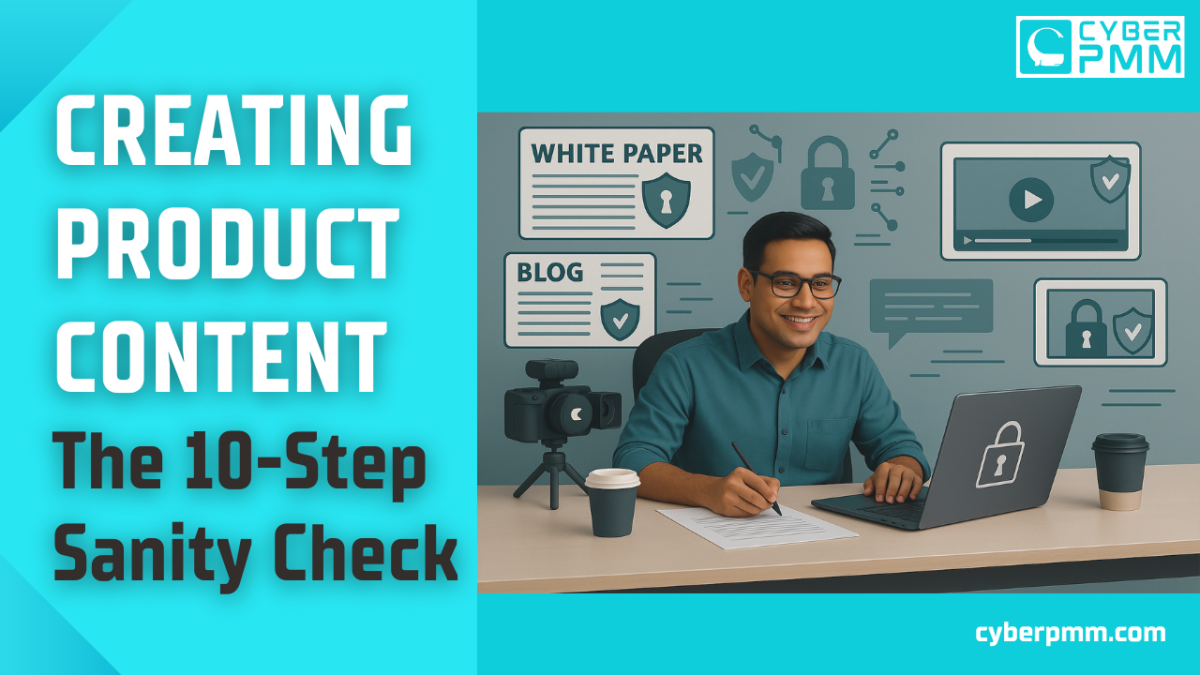Before you crank out another random asset, stop, drop and roll with these 10 product content creation steps.
If you’re creating product content without a strategy, a plan, or even a sanity check you’ve come to the write (intentional typo) place.
This guide walks through the 10 steps every PMM, builder, innovator (or anyone stuck wearing the hat) needs to follow before they open a new Doc. It’s not fluff. It’s not theoretical. It’s the checklist forged from pressure-tested experience.
You’re not just publishing content. You’re shaping the buyer experience. So let’s make sure it’s not digital chaos.
1. Start with Strategy: Define Your ICP and Messaging First
Don’t put the cart before the horse when it comes to creating content. If you haven’t gone through the strategic product messaging development process, and defining your ideal customer profile (ICP) you need to start there.
Anyone can come up with a simple message. It’s another story when you go through testing that message with internal groups, analysts and users needs to precede any attempt at creating content for buyers.
Read more on the Messaging Development
Read more on Message Testing
Why is this required? Because if you skip this step this means that you haven’t:
- a) thought through positioning and messaging targeted at your Ideal Customer Profile (ICP).
- b) pressure-tested your messages with the market. Slow down to speed up. Get your messaging house in order before you plan world domination.
None shall pass until this is done. With this first sanity check in place, let’s move to the next step.

2. Rethink Buyer’s Journey Maps as AI-Enabled Buyer’s Flows
AI innovation is forcing a rethink on content discoverability. I covered the reality of LLMs replacing Google Search and this will impact traffic to your website. Buyers are increasingly using LLMs to find and compare vendor information.
I don’t know about you but I only use Google Search maybe once a month. 95% of how I find answers now starts with LLMs, with more becoming voice-based. Also, buyer’s can now drum up a quick comparison table of your product’s features vs. your top competitors in seconds. The times are changing.
Read more on the AI-Enabled Buyer’s Flow
So while AI changes how buyers find info, your product content still powers the answers they get. We still need to get product content into the digital world that LLMs can surface. This means creating content within formats like web pages, videos and demos, because buyer’s using LLMs will pull in your product data from these sources.
What we produce should be LLM-friendly, not works of downloadable art. It’s becoming more about findability, speed and accuracy.

3. Write for Goldfish: Optimize for Short Attention Spans
These days, shorter content is usually better, unless you’re intentionally doing long form content to build trust. Security pros are busy and under a lot of pressure. They hate jargon. They want the point fast. Same goes for your demo’s.
Use BLUF: Bottom Line Up Front in all your assets. The gist of your content should be readable in seconds, in the first sentence.
If you’ve got a 3-page piece, cut it to 1-2. Ten slides? Make it 5. Always trim down. Mark Twain nailed it: “I would have sent you a shorter letter but I ran out of time.” Writing short is harder than writing long. Edit, re-edit, then edit again.
Your audience isn’t impressed by length. They’re impressed by efficiency.
4. Lead with Questions, Not Features
Before you start pumping out content, you need to figure out what questions your ICP is asking. Don’t start with your product, start with your buyer’s needs. Discover those questions through primary research, secondary research and prompt LLM’s to help you generate a list of potential questions.
Here’s a prompt: “You are a product marketer for <insert product/category>. You are starting to build a content plan for <insert ICP> and they are faced with <insert challenges>. Create a list of 10 succinct questions broken down into categories that I can use as the basis for content creation. Don’t use jargon. Make sure you don’t forget <insert key context>.”
5. Audit What You’ve Got Before Making More
Before you build content to map to those questions, take inventory and refresh existing content. If you have a Content Marketing function tracking analytics and inventory and notifying you of opportunities for refresh, count yourself lucky. Even better if they’re mapping your plans to buyer flows each quarter. Most likely, this won’t exist. And honestly, 90% of PMMs neglect this completely.
The key is just keeping track of each page, asset, demo – everything associated with your product. This is where the second “M” in PMM comes into play – you are Managing. It’s not sexy, but it’s essential stewardship of your product’s digital universe and buyer’s flow.
Before you build net new, check out what you have already and refresh based on changes that have happened. In Cyber, this will be a very short time span, usually only 6 months will pass before you’ll need to take inventory. Everything you produce is never really “final,” just “published.”
6. Ask Your Audience, Not Just the Mirror
If you don’t know what content is being used, ask those using it! Small data points shouldn’t drive your decisions.
- Conduct Field Surveys: Use broad field surveys. It’s like meetings – if you stopped showing up to that weekly call, would anyone notice? If not, stop going! If nobody notices if your old data sheet disappeared from the website, take it down. Ask the field, “What’s the single most used piece of content in your account conversations?” Rank the data. The less overhead to maintain, the better. Don’t make assumptions.
- Read survey results by analyst firms. Forrester once had a report where they ranked the top content across enterprise buyers. Conveniently, they showed that third-party analyst reports are trusted far more than anything a brand produces! As cynical as I can be, I actually do believe that is true based on what I’ve seen in market.
- Last but not least, ask your USERS directly. At user events, sending forms, wherever you can, ask them what they used to find your product. Ask them what content they wish they had. Bingo. There’s your golden nugget.
7. Get Feedback, Not Perfection
On a deadline? Work backward at least 4 weeks for feedback. You’re one ticket in a crowded queue.
Give SMEs a week. And always set a deadline: “Need feedback by EOD Friday — moving forward after that.” Ask for insights, not grammar edits — no one needs to channel their inner English professor.
Yes, you could whip it up in Canva and ChatGPT solo. But in big orgs, approvals are layered and tools are locked down. Complex companies = complex workflows.
We’ve all been there:
Slack pings post-launch — “Did PM review this?”
Cue panic. You skipped peer review, now you’re backpedaling. Peer reviews save this fire drill from happening. It’s fast. Sometimes it’s “add a comma.” Sometimes it’s “that feature’s dead.”
Share early. Every time.
Perfection kills momentum. First drafts should be ugly. Share. Improve. Repeat.
Receive late input? Add it into the next version.

8. Know the Agency vs. Internal Tradeoff
Ok, so you have a final draft with sign offs and you’re ready to ship content. Should be easy right? Not so fast. Every company handles creative production differently but I almost always prefer outsourcing to agencies. Why? Simple. Internal creative teams get bogged down and in many cases they use agencies themselves. Corporate processes slow everyone down. Designers take PTO. Different departments fight for priority.
With agencies, you pay for results. The speed and quality can’t be matched by internal teams. But that decision isn’t yours to make as a PMM. Your VP or Director controls that budget. If you’re the VP or Director making the call, consider enabling your team with a direct line into an agency.
But most likely, you’ll deal with internal creative teams. Nothing against these teams, as I love the people on creative teams, but I’m opposed to the process friction and reality that they aren’t as efficient as agencies.
9. Navigate Internal Creative Teams Like a Pro
Internal designers love their templates and ticketing processes. They have SLAs to protect themselves from getting swamped. Here’s the irony: most “Creative” teams are the most process-oriented people in the company.
They’re not “creating”; they’re “processing.” Creativity follows a process, and they need it to keep up. Totally get it. No judgment from me.
This means PMMs have to be super prescriptive with our requests. Don’t just submit a ticket expecting them to say, “Yes mam, right away mam!” That never happens. Instead, they’ll say, “fill this form and stand in line, next!” It’s not exactly like the DMV, but it kinda is. The more details you provide upfront, the better.
Tip: “The more time you spend on the creative ticket request, the less time you’ll spend fixing it later.
When I submit Creative tickets, I follow Abe Lincoln’s thinking: “If I had 5 hours to chop down a tree, I’d spend 4 hours sharpening my ax.” Same goes for creating content. It’s similar to prompt engineering. If you are lax in your prompts, you’ll get bad LLM outputs.
10. Plan for the Publish: Web, Legal, and Demand Gen Hurdles
Got your asset back from Creative? Great. Now you face the Web team to publish it. This is not as easy as you think.
The Web team is just as busy as Creative. You’re a small fish in their ocean of priorities. Plus, publishing externally needs Legal review. Once it’s out there, you can’t take it back. The dreaded “was this reviewed by Legal?” response will rain on your parade quickly.
The Web team has their own ticketing process and SLAs too. Work with them. Don’t make everything urgent. Save those rush orders for when you really need them.
Then you’ll work with Demand Gen to promote your content. They’ll integrate your assets into their programs. Build these relationships early. Let them know what you’re working on. I’ve had great partners who shared historical data and helped align my content with their campaigns.
Closing
If it feels like a lot, that’s because it is.
Creating product content isn’t just about writing. It’s about orchestration. Messaging, timing, approvals, reviews, formats, handoffs, promotion. And if any piece is off, the whole thing can fall flat.
But when you follow this 10-step sanity check, you build with intention. You stop wasting time. You stop shipping half-baked ideas. You start owning the process.
The mission of Cyber PMM 🐳 is to provide open source content, tools and frameworks that help Cyber PMMs fight digital chaos, cut through the hype, and do more with less.
Cyber PMMs are primarily product marketers in cybersecurity, but this space also supports tech founders, solutions marketers, product managers, engineers, and content creators—anyone bringing tech to market in chaotic environments.
⤵️ Join the conversation with other Cyber PMMs
- Subscribe to the newsletter on LinkedIn or Substack. (You can also subscribe directly below.)
- Follow Cyber PMM and/or me on LinkedIn.
- Subscribe to the YouTube channel.
- Subscribe to the Podcast on Spotify or Apple.
- Follow on X and @Cyber_PMM on Instagram.


